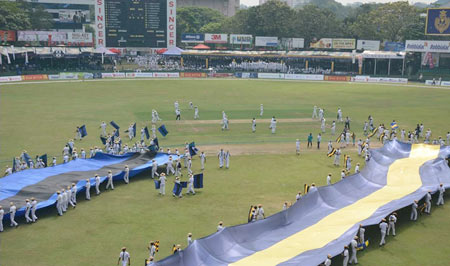The unifying power of South Asian cricket
by Marwaan Macan-Markar
On a Saturday in March, as Colombo sizzled under a fierce sun,
SriLanka's 66-year-old Prime Minister Ranil Wickremesinghe took a break
from politics to return to the world of his youth.
|

The prefects of Royal and S. Thomas’ displaying their
respective flags during a break in a ‘Battle of the Blues’
encounter |
The occasion was a cricket match between his high school, Royal
College, and cross town rival S. Thomas.' Thematch has been played for
137 straight years, a record in cricketing annals.To the uninitiated,
the Premier's presence - complete with a canary yellow shirt, the colour
of his almamater- might have looked like an embarrassing attempt to
cling to adolescence. But appearances can be deceptive, perhaps never
more so than with oddities such as this Sri Lankan event centered on an
English sport introduced, like the schools themselves, during the
island's years of British colonization.
The Prime Minister was simply following the tradition that the
country's political leaders attend the annual match if they hail from
either school.
For these politicians, the event offers a chance to put aside
ideological differences and indulge in a few hours of singing and
wisecracks. But the match also serves as a measure of social cohesion in
this ethnically divided country. Alumni from the country's majority
Sinhalese and minority Tamil populations- divided by nearly 30 years of
conflict that ended only in 2009 -put bitterness aside during the three
days of cricket, which are always played in a spirit of bonhomie. A
common sight during the war years was spectators from both communities
regaling each other with the shared experiences of youth. The rawness of
Sri Lanka's recent experience contrasts with the cheerycamaraderie of
players and spectators. But the country is not alone in benefiting from
cricket's capacity to bring together divided communities.
There are parallels all over South Asia among countries that picked
up the passion for hitting a leather ball with a wooden bat while under
the British Raj. One example is the current presence of Pakistan's
national team in India for the T20 World Cup, the top international
tournament in the shortest and newest form of the game, which started in
mid-March.Casting out caste India-Pakistan matches, now rare because of
political disputes, have served as a barometer of the frequent freezes
and thaws in relations between the two countries, which were governed as
a single unit under the Raj."Cricket diplomacy" has been used to good
effect several times -notably when Indian leaders invited their
Pakistani counterparts to watch matches in India between the two South
Asian rivals.
The growth of this British colonial import in India, now a cricketing
power house and the financial center of gravity for the game, has been
credited with shaking up a subcontinent hobbled by rigid
castehierarchies. As Ramachandra Guha, an Indian historian, notes in
hisbook, "ACorner of a Foreign Field: The Indian History of a British
Sport,"the opportunity for low-caste Indians to play cricket undermined
the caste system in colonial and post-colonial times.
There was no way around the need for 11 players for each cricket
team,which forced the upper castes to look for talent beyond their
ownranks. This opened up a venue to advancement for players such as
Palwankar Baloo, a low-caste Hindu, who was one of India's star bowlers
from 1905 to 1921.In many of Britain's colonies, teams representing the
colonizers battled it out with teams of the colonized in matches.
Independence has added an extra dimension: Beating the English team has
become a mark of national pride and the ability to perform at the top
level on an international sporting stage has helped to shape national
unity in many former colonies in the Asia-Pacific, Africa and the
Caribbean. That was how it felt in March 1996, when an underdog Sri
Lankan team beat the heavily favoured Australians at the World Cup
finals of one-day cricket in Pakistan. I celebrated with millions of Sri
Lankans that night and the next day. For a moment, we forgot about the
civil war as even supporters of the Tamil Tiger rebels waved Sri Lankan
flags.
On that day cricket, for us, was truly more than a sport.Marwaan
Macan-Markar is a contributor to the Nikkei Asian Review and acricket
fan.
- Nikkei Asian Review
|

